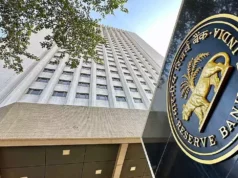The stock of Axis Bank has increased by 12% during the last six months, but its share price has dropped by more than 8% in a single month. Axis Bank’s stock has increased 63% over the last three years, but it has down 15% in the last year. Over the last five years, the share price of Axis Bank has increased by an astounding 157%.
Early Friday trading saw a 7% decline in the price of Axis Bank shares after the private lender let Dalal Street investors down with subpar Q1 results. On the BSE, shares of Axis Bank dropped as much as 7.4% to ₹1,073.95.
For the fiscal first quarter that ended in June 2025, Axis Bank’s net profit decreased 3.8% to ₹5,806.14 crore from ₹6,034.64 crore during the same period last year.
In Q1FY26, net interest income (NII) increased 0.8% year over year (YoY) to ₹13,560 crore from ₹13,448 crore. Compared to 3.97% in the prior quarter and 4.05% in the same time last year, the Net Interest Margin (NIM) was 3.80% for the quarter.
The gross non-performing asset (NPA) ratio increased from 1.28% on March 31, 2025, to 1.57% on June 30, 2025, indicating a decline in asset quality. In Q1FY26, the bank’s net non-performing asset (NPA) ratio climbed from 0.33% to 0.45%.
Dalal Street investors were disappointed by Axis Bank’s poor first-quarter results, which led analysts to downgrade the stock and lower their share price forecasts and profit projections. The following are the opinions of analysts regarding Axis Bank’s first-quarter earnings and stock price:
Institutional Equities in Nuvama
Axis Bank reported a significant asset quality shortfall and undershot on Q1FY26 NIM. A ₹82 billion (3.1%) slippage is 72% greater QoQ. Even core slippage and credit costs increased year over year and year over year, surpassing peers and normalized levels. Even though Axis Bank has been the slowest of its peers to enact rate cuts, NIM declined 17 basis points on a quarterly basis, according to Nuvama Institutional Equities.
Due to persistent volatility in asset quality and growth, the brokerage firm downgraded Axis Bank shares to “Hold.” Axis Bank’s share price objective was dropped from ₹1,400 to ₹1,180, while FY26E and FY27E EPS expectations were cut by 5% and 6%, respectively, on an already below-consensus base.
Axis Bank’s stock discount to peers will increase due to volatility, it stated, and it has more catch-up to make on rate cuts than rivals.
Oswal Motilal
Axis Bank’s asset quality declined as slippages increased as a result of strict loan classification (technical impact), according to Motilal Oswal Financial Services, and the ratios of gross non-performing assets (NPA) and net non-performing assets (NPA) also increased.
Taking into account increased credit costs and margin pressure, it reduced earnings projections for FY26 and FY27 by 8.6% and 5.7%, respectively. RoA and RoE for FY27E are estimated to be 1.6% and 14.6%, respectively. With a target price of ₹1,250 per share, the brokerage company continues to maintain its “Neutral” rating on Axis Bank shares.
Capital IIFL
According to IIFL Capital, Axis Bank’s net profit for FY26 will drop 12% year over year but rise sharply in FY27, indicating an 11% CAGR for FY26–28E earnings.
The share price of Axis Bank is at 1.4x FY27E P/B, which is almost 40% less than that of its rival banks. This gives the stock price a floor. It is challenging to argue for outperformance in comparison to peers, though, given the approaching NIM pressure, the persistently high credit costs in the second and third quarters, and the uneven execution, according to IIFL Capital.
The Axis Bank share price goal is lowered from ₹1,370 to ₹1,280, a 4-8% reduction in forecasts.
Technical Prospects
According to Anshul Jain, Head of Research at Lakshmishree Investments, the post-result gap-down in Axis Bank shares has changed into an open-low pattern, and the stock is beginning to show indications of a recovery.
It appears from this price movement that purchasers are absorbing the drop. With the gap-fill’s upper end set at ₹1,151, there is immediate upside potential. Despite the significant volume during the gap-down, the absence of further selling suggests accumulation rather than panic, suggesting a potential short-term rebound, according to Jain.
Performance of Axis Bank’s Share Price
The stock of Axis Bank has increased by 12% during the last six months, but its share price has dropped by more than 8% in a single month. Axis Bank’s stock has increased 63% over the last three years, but it has down 15% in the last year. Over the last five years, the share price of Axis Bank has increased by an astounding 157%.
The price of Axis Bank’s shares was down 4.31% at ₹1,109.90 a share on the BSE at 9:25 AM.






